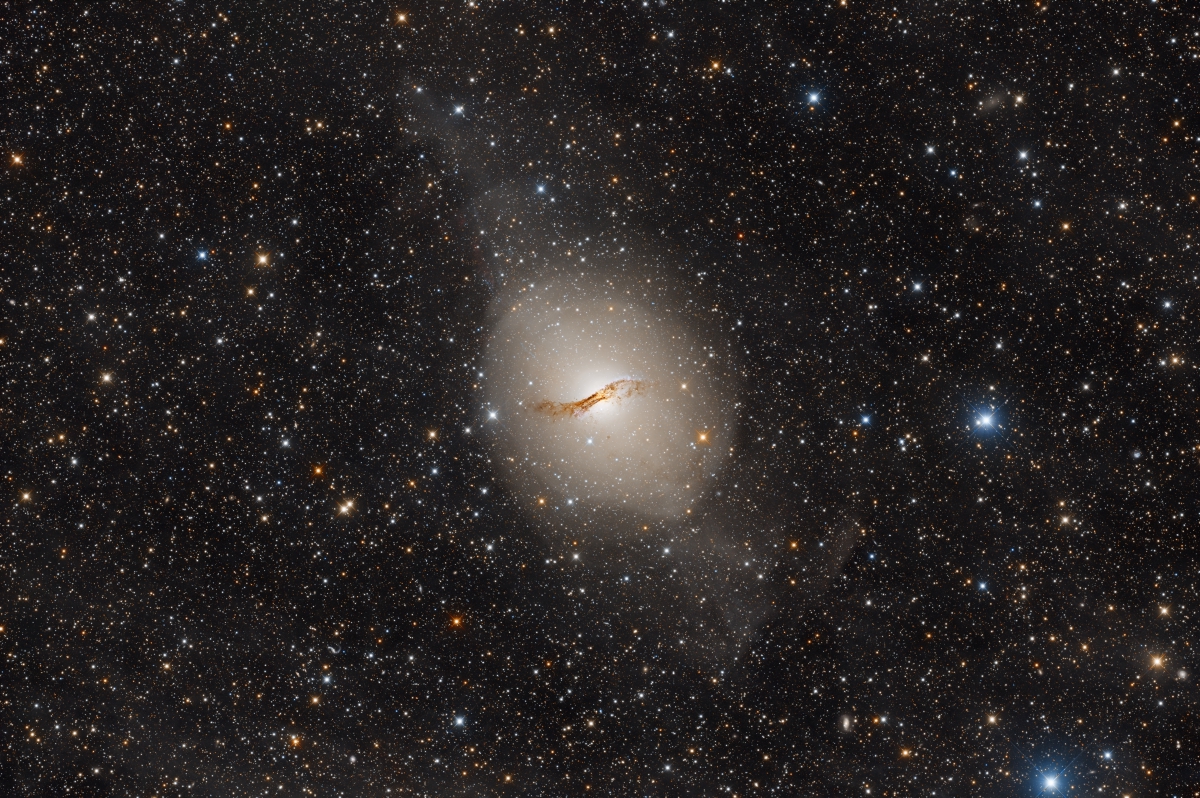
[back] Rhea First Look image of NGC 5128 (Centaurus A) in Centaurus [NED]
Higher resolved uncroped LRGB image /
höher aufgelöstes unbeschnittenes LRGB-Bild (9422 x
6265 Pixel, 0.74"/pixel)
Higher resolved uncroped LRGB-HaOIII image /
höher aufgelöstes unbeschnittenes LRGB-HaOIII-Bild (9422
x 6265 Pixel, 0.74"/pixel)
HDR-Animation
(invertierter L-Kanal) /
HDR animation (inverted L) (4k mp4)
Animation of LRGB and LRGB-HaOIII version

|
Type S0 pec |
|
300" |
|
(c) 2025 All astro photo images are copyrighted. They may not be used or reproduced without explicit written permission from the authors.
About this Image / Über dieses Bild
| Camera: | Moravian C3-PRO-61000 Mono CMOS |
| Image Type, Orientation: | L-RGB-HaOIII Color Composite, North is at 12:00 |
| Exposure time: | L:87x300s, R: 82x300s, G: 85x300s, B: 91x300s, Ha: 108x900s, OIII: 75x900s (74:30h total) |
| Exposure date: | April 27th, 2023.. May 28th, 2024 |
| Location: | Capella Observatory South at Kiripotib Astro Farm, Namibia |
| Filter: | Astronomik Deep-Sky Deep-Sky RGB Filter plus 6nm Ha, OIII filters on Moravian EFW-3L-9-II External Filter Wheel |
| Instrument: | "Rhea", a PlaneWave DeltaRho 350, 1050mm focal length, 350mm aperture, f/3 on 10Micron GM2000 HPS II Combi |
| Photographer: | Rainer Raupach, Frank Sackenheim, Stefan Binnewies, Josef Pöpsel |
|
Remarks: |
In April 2025, Josef
installed our new telescope along with its mount in Namibia. Shortly
thereafter, we were able to capture first light with the powerful DeltaRho
telescope by Planewave. The target for this initial real observation was a
classic object of the southern sky: the galaxy NGC 5128, better known as Centaurus A. This designation already hints at its strong emission in the radio wavelength range. Centaurus A is one of the brightest extragalactic radio sources in the sky. At the center of the galaxy lies a supermassive black hole from which a so-called relativistic jet emerges. We were able to depict the optical components of this jet using narrowband H-alpha and OIII filters. The brightest part of the jet extends in a northeasterly direction. The counter-jet of this bipolar structure is also faintly visible at the southwestern edge of the galaxy. The HaOIII-image uses the so called continuum subtraction to clearly seperate the Ha- and OIII-signal from the continuum of the galaxy. Centaurus A is well known for the prominent dust lane that runs through the central part of the galaxy. Otherwise, the galaxy shows few structures, which is typical of an elliptical galaxy. In the 1980s, astrophotography pioneer David Malin discovered something unusual on a photographic plate of Centaurus A. When he applied an unsharp mask filter to the image, faint shell structures became visible in the galaxy's body that had previously gone unnoticed. These shells provided evidence of a past collision between Centaurus A and another galaxy. Such an interaction could also explain the relatively high rate of star formation and the galaxy’s central activity. In terms of color, Centaurus A appears noticeably reddish. This has several likely causes. On the one hand, it relates to the galaxy’s stellar population, which includes many red stars. On the other hand, extinction plays a role—that is, the attenuation of short-wavelength light by dust—both within the galaxy itself and due to its location in the sky. In an inverted version of our image (animation see below), one can clearly see that Centaurus A lies in a region of the sky affected by gas and dust from our own Milky Way. This is known as galactic cirrus, which appears as dark filamentary structures present throughout the image. |
|
Bemerkungen: |
Im April 2025 hat Josef unser neues
Teleskop samt Montierung in Namibia installiert. Bereits kurz darauf konnten
wir mit dem lichtstarken DeltaRho der Firma Planewave das First Light
einfangen. Ziel für diese erste wirkliche Aufnahme war ein klassisches Objekt des
Südhimmels: die Galaxie NGC 5128, besser bekannt als Centaurus A. |
Inverted view of
the luminance of the LRGB image with animated contrast
Invertierte Darstellung der Luminanz des LRGB-Bildes mit animiertem Kontrast

(c) 2025 All astro
photo images are copyrighted. They may not be used or reproduced without
explicit written permission from the authors.
Back to the Galaxies' Overview / Zurück zur Galaxien-Übersichtsseite